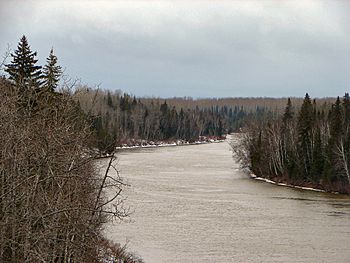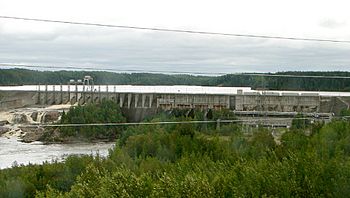Abitibi River facts for kids
Quick facts for kids Abitibi River |
|
|---|---|

Abitibi River at Iroquois Falls
|
|
|
Location of the mouth of the Abitibi River in Ontario
|
|
| Country | Canada |
| Province | Ontario |
| District | Cochrane |
| Physical characteristics | |
| Main source | Lake Abitibi 38 km east of Iroquois Falls 48°47′06″N 80°10′23″W / 48.78500°N 80.17306°W |
| River mouth | Moose River 30 km SSW from Moosonee 51°04′17″N 80°55′32″W / 51.07139°N 80.92556°W |
| Length | 540 m (1,770 ft)to head of Lac Loïs |
| Basin features | |
| Basin size | 29,500 km2 (11,400 sq mi) |
| Tributaries |
|
The Abitibi River is a river in northeastern Ontario, Canada, which flows northwest from Lake Abitibi to join the Moose River which empties into James Bay. This river is 540 kilometres (340 mi) long, and descends 265 metres (869 ft).
Abitibi is an Amerindian word meaning "halfway water", derived from abitah, which may be translated as "middle" or "halfway", and nipi, "water". Originally used by the French to designate a band of Algonquin Indians who lived near the lake, the name was descriptive of their location halfway between the trading posts on the Hudson Bay and those on the Ottawa River.
The river was an important fur trading route for the Hudson's Bay Company. Formerly, pulp and paper, centered on the town of Iroquois Falls, Ontario, was an important industry in the heavily forested region through which it flows. The region also supports tourism and gold mining.
The Abitibi Canyon Generating Station is located on the river at Abitibi Canyon. The experience of surveying the river for the purposes of building this plant was the inspiration for folk singer Wade Hemsworth's "The Black Fly Song".
The name is from the Algonquin words abitah, meaning middle and nipi meaning water.
Tributaries
- Little Abitibi River
- Frederick House River
- Black River
Downstream course
- Begins as outlet from Lake Abitibi (48°47′6″N 80°10′23″W / 48.78500°N 80.17306°W)
- Extreme southern point (48°42′26″N 80°38′25″W / 48.70722°N 80.64028°W)
- Ansonville, Ontario (48°45′26″N 80°40′43″W / 48.75722°N 80.67861°W)
- Iroquois Falls, Ontario (48°46′41″N 80°40′6″W / 48.77806°N 80.66833°W)
- Crossed by Ontario Northland Railway (49°12′43″N 81°0′37″W / 49.21194°N 81.01028°W)
- Long Sault Rapids hydroelectric plant (49°12′44″N 81°0′52″W / 49.21222°N 81.01444°W)
- Confluence with the Black River (49°20′58″N 81°6′34″W / 49.34944°N 81.10944°W)
- Confluence with the Frederick House River (49°18′51″N 81°16′58″W / 49.31417°N 81.28278°W)
- Ontario Northland Railway crossing at Island Falls Station, Ontario (49°32′53″N 81°22′56″W / 49.54806°N 81.38222°W)
- Island Falls, Ontario (49°34′3″N 81°23′16″W / 49.56750°N 81.38778°W)
- Abitibi Canyon Generating Station near Fraserdale, Ontario (49°53′42″N 81°34′42″W / 49.89500°N 81.57833°W)
- Otter Rapids Generating Station (50°10′57″N 81°38′37″W / 50.18250°N 81.64361°W)
- Coral Rapids, Ontario (50°13′17″N 81°40′33″W / 50.22139°N 81.67583°W)
- Extreme western point (50°15′25″N 81°40′48″W / 50.25694°N 81.68000°W)
- Confluence with the Little Abitibi River (50°29′29″N 81°32′7″W / 50.49139°N 81.53528°W)
- Joins the Moose River (51°4′17″N 80°55′32″W / 51.07139°N 80.92556°W)
- Enters James Bay as part of the Moose River (51°21′14″N 80°24′14″W / 51.35389°N 80.40389°W)
Images for kids
See also
 In Spanish: Río Abitibi para niños
In Spanish: Río Abitibi para niños




